The Interplay of Language, Learning, and Community (APPL912)
VerifiedAdded on 2023/03/17
|9
|2895
|49
Essay
AI Summary
This essay delves into the multifaceted relationship between language and community, exploring how language shapes individual identities, community roles, and cultural understanding. It examines the Whorfian hypothesis, which posits that language influences thought, and discusses examples of how language structures, such as the use of tenses in English versus Chinese and the categorization of colors, can affect perceptions and behaviors. The essay also considers the impact of community on language, including the influence of the number of deaf people in a community and the manipulation of language by those in power. Furthermore, the essay discusses how language can reflect and perpetuate sexism, and how the loss of a language can lead to the loss of a unique worldview. Through various examples and scholarly perspectives, the essay provides a comprehensive analysis of the dynamic interplay between language and the communities that use it.
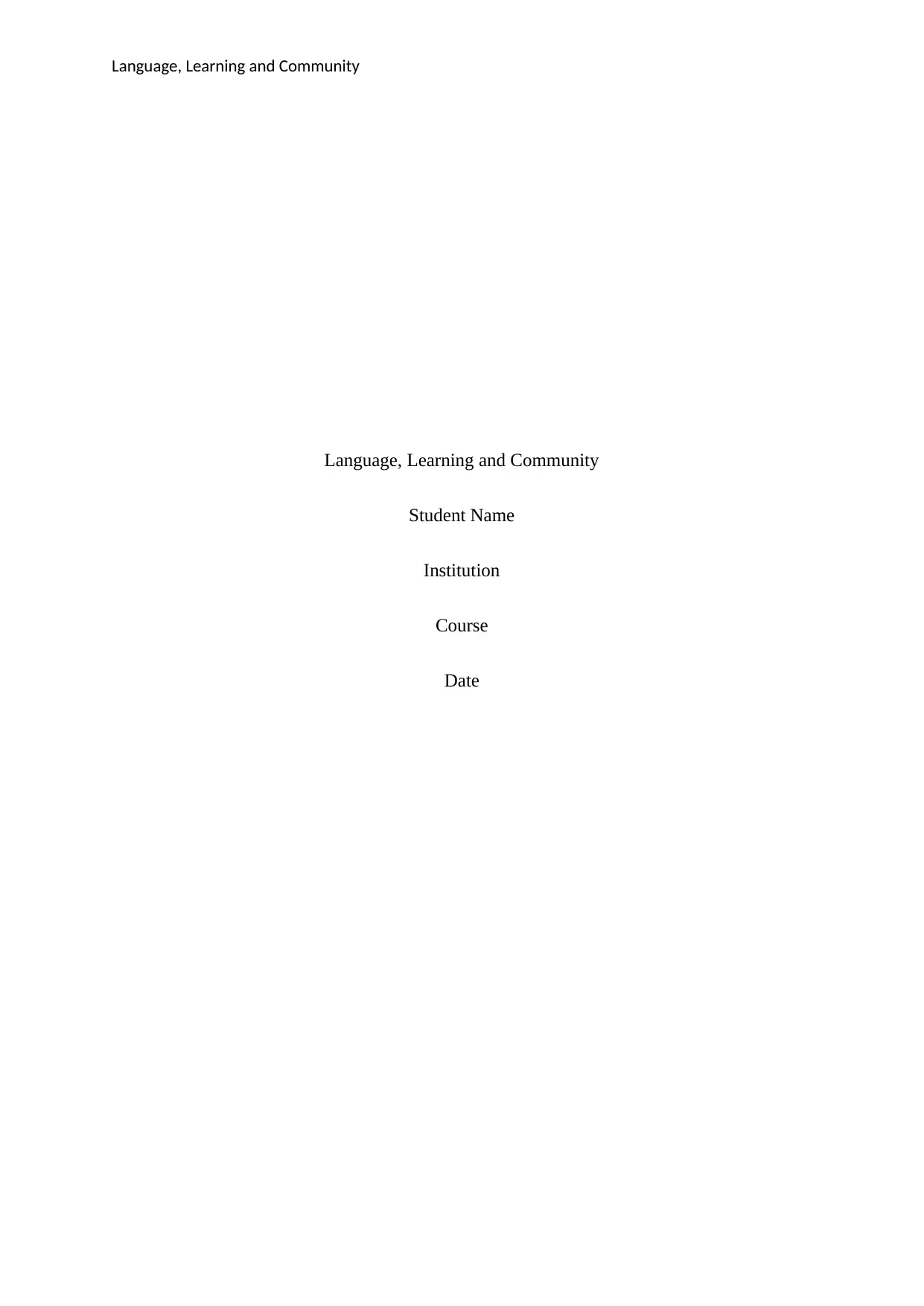
Language, Learning and Community
Language, Learning and Community
Student Name
Institution
Course
Date
Language, Learning and Community
Student Name
Institution
Course
Date
Secure Best Marks with AI Grader
Need help grading? Try our AI Grader for instant feedback on your assignments.
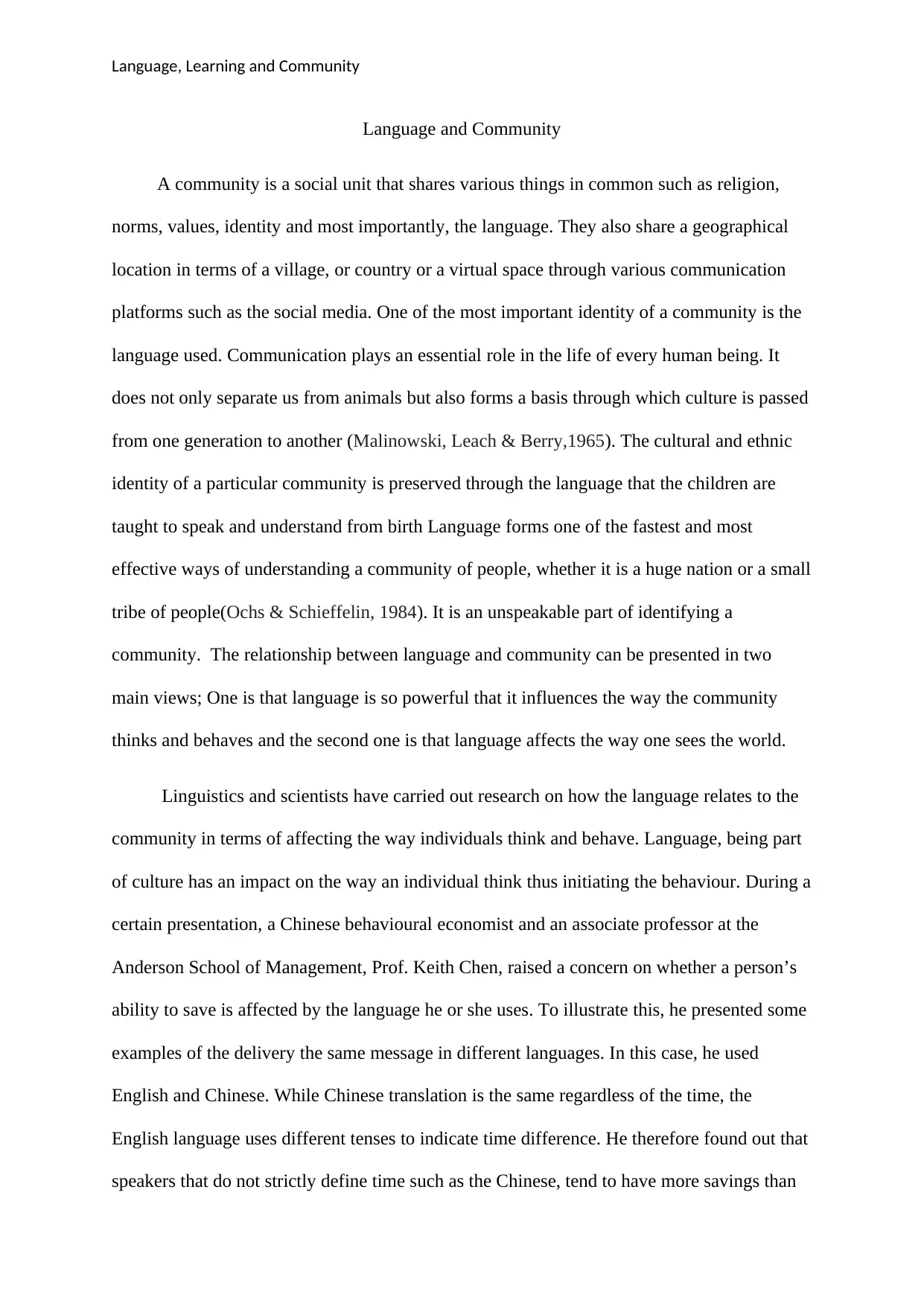
Language, Learning and Community
Language and Community
A community is a social unit that shares various things in common such as religion,
norms, values, identity and most importantly, the language. They also share a geographical
location in terms of a village, or country or a virtual space through various communication
platforms such as the social media. One of the most important identity of a community is the
language used. Communication plays an essential role in the life of every human being. It
does not only separate us from animals but also forms a basis through which culture is passed
from one generation to another (Malinowski, Leach & Berry,1965). The cultural and ethnic
identity of a particular community is preserved through the language that the children are
taught to speak and understand from birth Language forms one of the fastest and most
effective ways of understanding a community of people, whether it is a huge nation or a small
tribe of people(Ochs & Schieffelin, 1984). It is an unspeakable part of identifying a
community. The relationship between language and community can be presented in two
main views; One is that language is so powerful that it influences the way the community
thinks and behaves and the second one is that language affects the way one sees the world.
Linguistics and scientists have carried out research on how the language relates to the
community in terms of affecting the way individuals think and behave. Language, being part
of culture has an impact on the way an individual think thus initiating the behaviour. During a
certain presentation, a Chinese behavioural economist and an associate professor at the
Anderson School of Management, Prof. Keith Chen, raised a concern on whether a person’s
ability to save is affected by the language he or she uses. To illustrate this, he presented some
examples of the delivery the same message in different languages. In this case, he used
English and Chinese. While Chinese translation is the same regardless of the time, the
English language uses different tenses to indicate time difference. He therefore found out that
speakers that do not strictly define time such as the Chinese, tend to have more savings than
Language and Community
A community is a social unit that shares various things in common such as religion,
norms, values, identity and most importantly, the language. They also share a geographical
location in terms of a village, or country or a virtual space through various communication
platforms such as the social media. One of the most important identity of a community is the
language used. Communication plays an essential role in the life of every human being. It
does not only separate us from animals but also forms a basis through which culture is passed
from one generation to another (Malinowski, Leach & Berry,1965). The cultural and ethnic
identity of a particular community is preserved through the language that the children are
taught to speak and understand from birth Language forms one of the fastest and most
effective ways of understanding a community of people, whether it is a huge nation or a small
tribe of people(Ochs & Schieffelin, 1984). It is an unspeakable part of identifying a
community. The relationship between language and community can be presented in two
main views; One is that language is so powerful that it influences the way the community
thinks and behaves and the second one is that language affects the way one sees the world.
Linguistics and scientists have carried out research on how the language relates to the
community in terms of affecting the way individuals think and behave. Language, being part
of culture has an impact on the way an individual think thus initiating the behaviour. During a
certain presentation, a Chinese behavioural economist and an associate professor at the
Anderson School of Management, Prof. Keith Chen, raised a concern on whether a person’s
ability to save is affected by the language he or she uses. To illustrate this, he presented some
examples of the delivery the same message in different languages. In this case, he used
English and Chinese. While Chinese translation is the same regardless of the time, the
English language uses different tenses to indicate time difference. He therefore found out that
speakers that do not strictly define time such as the Chinese, tend to have more savings than
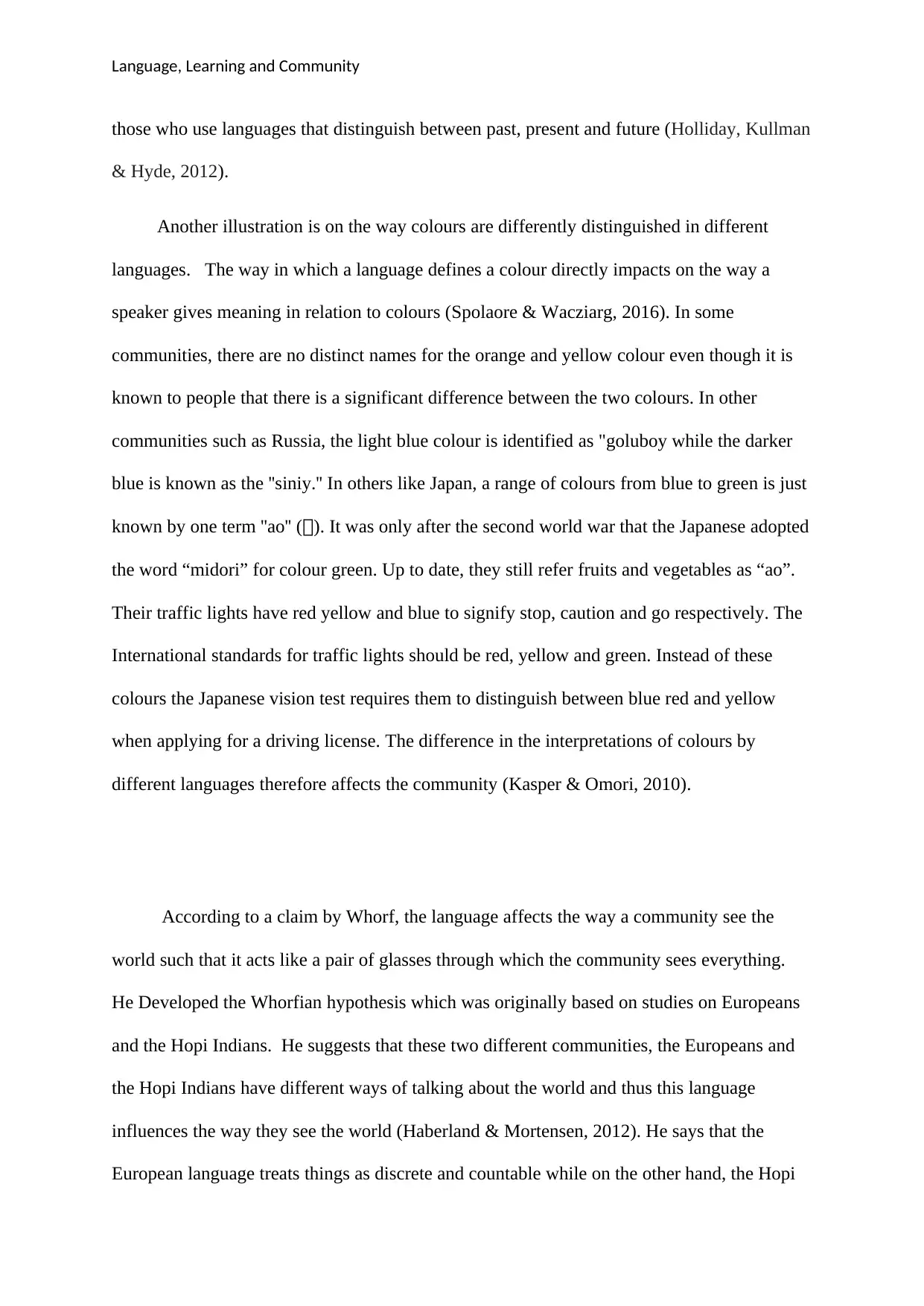
Language, Learning and Community
those who use languages that distinguish between past, present and future (Holliday, Kullman
& Hyde, 2012).
Another illustration is on the way colours are differently distinguished in different
languages. The way in which a language defines a colour directly impacts on the way a
speaker gives meaning in relation to colours (Spolaore & Wacziarg, 2016). In some
communities, there are no distinct names for the orange and yellow colour even though it is
known to people that there is a significant difference between the two colours. In other
communities such as Russia, the light blue colour is identified as "goluboy while the darker
blue is known as the ''siniy.'' In others like Japan, a range of colours from blue to green is just
known by one term ''ao'' (青). It was only after the second world war that the Japanese adopted
the word “midori” for colour green. Up to date, they still refer fruits and vegetables as “ao”.
Their traffic lights have red yellow and blue to signify stop, caution and go respectively. The
International standards for traffic lights should be red, yellow and green. Instead of these
colours the Japanese vision test requires them to distinguish between blue red and yellow
when applying for a driving license. The difference in the interpretations of colours by
different languages therefore affects the community (Kasper & Omori, 2010).
According to a claim by Whorf, the language affects the way a community see the
world such that it acts like a pair of glasses through which the community sees everything.
He Developed the Whorfian hypothesis which was originally based on studies on Europeans
and the Hopi Indians. He suggests that these two different communities, the Europeans and
the Hopi Indians have different ways of talking about the world and thus this language
influences the way they see the world (Haberland & Mortensen, 2012). He says that the
European language treats things as discrete and countable while on the other hand, the Hopi
those who use languages that distinguish between past, present and future (Holliday, Kullman
& Hyde, 2012).
Another illustration is on the way colours are differently distinguished in different
languages. The way in which a language defines a colour directly impacts on the way a
speaker gives meaning in relation to colours (Spolaore & Wacziarg, 2016). In some
communities, there are no distinct names for the orange and yellow colour even though it is
known to people that there is a significant difference between the two colours. In other
communities such as Russia, the light blue colour is identified as "goluboy while the darker
blue is known as the ''siniy.'' In others like Japan, a range of colours from blue to green is just
known by one term ''ao'' (青). It was only after the second world war that the Japanese adopted
the word “midori” for colour green. Up to date, they still refer fruits and vegetables as “ao”.
Their traffic lights have red yellow and blue to signify stop, caution and go respectively. The
International standards for traffic lights should be red, yellow and green. Instead of these
colours the Japanese vision test requires them to distinguish between blue red and yellow
when applying for a driving license. The difference in the interpretations of colours by
different languages therefore affects the community (Kasper & Omori, 2010).
According to a claim by Whorf, the language affects the way a community see the
world such that it acts like a pair of glasses through which the community sees everything.
He Developed the Whorfian hypothesis which was originally based on studies on Europeans
and the Hopi Indians. He suggests that these two different communities, the Europeans and
the Hopi Indians have different ways of talking about the world and thus this language
influences the way they see the world (Haberland & Mortensen, 2012). He says that the
European language treats things as discrete and countable while on the other hand, the Hopi
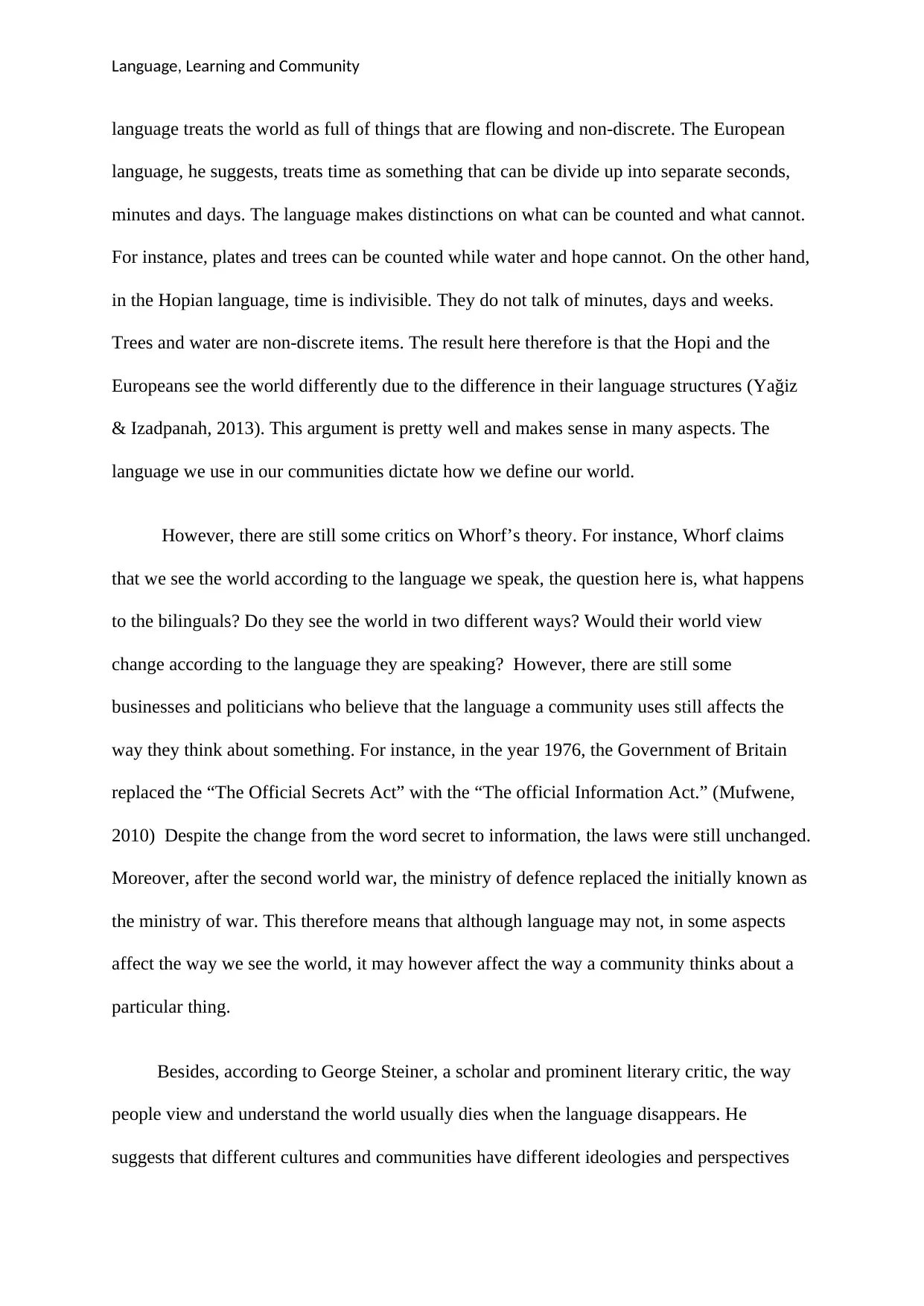
Language, Learning and Community
language treats the world as full of things that are flowing and non-discrete. The European
language, he suggests, treats time as something that can be divide up into separate seconds,
minutes and days. The language makes distinctions on what can be counted and what cannot.
For instance, plates and trees can be counted while water and hope cannot. On the other hand,
in the Hopian language, time is indivisible. They do not talk of minutes, days and weeks.
Trees and water are non-discrete items. The result here therefore is that the Hopi and the
Europeans see the world differently due to the difference in their language structures (Yağiz
& Izadpanah, 2013). This argument is pretty well and makes sense in many aspects. The
language we use in our communities dictate how we define our world.
However, there are still some critics on Whorf’s theory. For instance, Whorf claims
that we see the world according to the language we speak, the question here is, what happens
to the bilinguals? Do they see the world in two different ways? Would their world view
change according to the language they are speaking? However, there are still some
businesses and politicians who believe that the language a community uses still affects the
way they think about something. For instance, in the year 1976, the Government of Britain
replaced the “The Official Secrets Act” with the “The official Information Act.” (Mufwene,
2010) Despite the change from the word secret to information, the laws were still unchanged.
Moreover, after the second world war, the ministry of defence replaced the initially known as
the ministry of war. This therefore means that although language may not, in some aspects
affect the way we see the world, it may however affect the way a community thinks about a
particular thing.
Besides, according to George Steiner, a scholar and prominent literary critic, the way
people view and understand the world usually dies when the language disappears. He
suggests that different cultures and communities have different ideologies and perspectives
language treats the world as full of things that are flowing and non-discrete. The European
language, he suggests, treats time as something that can be divide up into separate seconds,
minutes and days. The language makes distinctions on what can be counted and what cannot.
For instance, plates and trees can be counted while water and hope cannot. On the other hand,
in the Hopian language, time is indivisible. They do not talk of minutes, days and weeks.
Trees and water are non-discrete items. The result here therefore is that the Hopi and the
Europeans see the world differently due to the difference in their language structures (Yağiz
& Izadpanah, 2013). This argument is pretty well and makes sense in many aspects. The
language we use in our communities dictate how we define our world.
However, there are still some critics on Whorf’s theory. For instance, Whorf claims
that we see the world according to the language we speak, the question here is, what happens
to the bilinguals? Do they see the world in two different ways? Would their world view
change according to the language they are speaking? However, there are still some
businesses and politicians who believe that the language a community uses still affects the
way they think about something. For instance, in the year 1976, the Government of Britain
replaced the “The Official Secrets Act” with the “The official Information Act.” (Mufwene,
2010) Despite the change from the word secret to information, the laws were still unchanged.
Moreover, after the second world war, the ministry of defence replaced the initially known as
the ministry of war. This therefore means that although language may not, in some aspects
affect the way we see the world, it may however affect the way a community thinks about a
particular thing.
Besides, according to George Steiner, a scholar and prominent literary critic, the way
people view and understand the world usually dies when the language disappears. He
suggests that different cultures and communities have different ideologies and perspectives
Secure Best Marks with AI Grader
Need help grading? Try our AI Grader for instant feedback on your assignments.
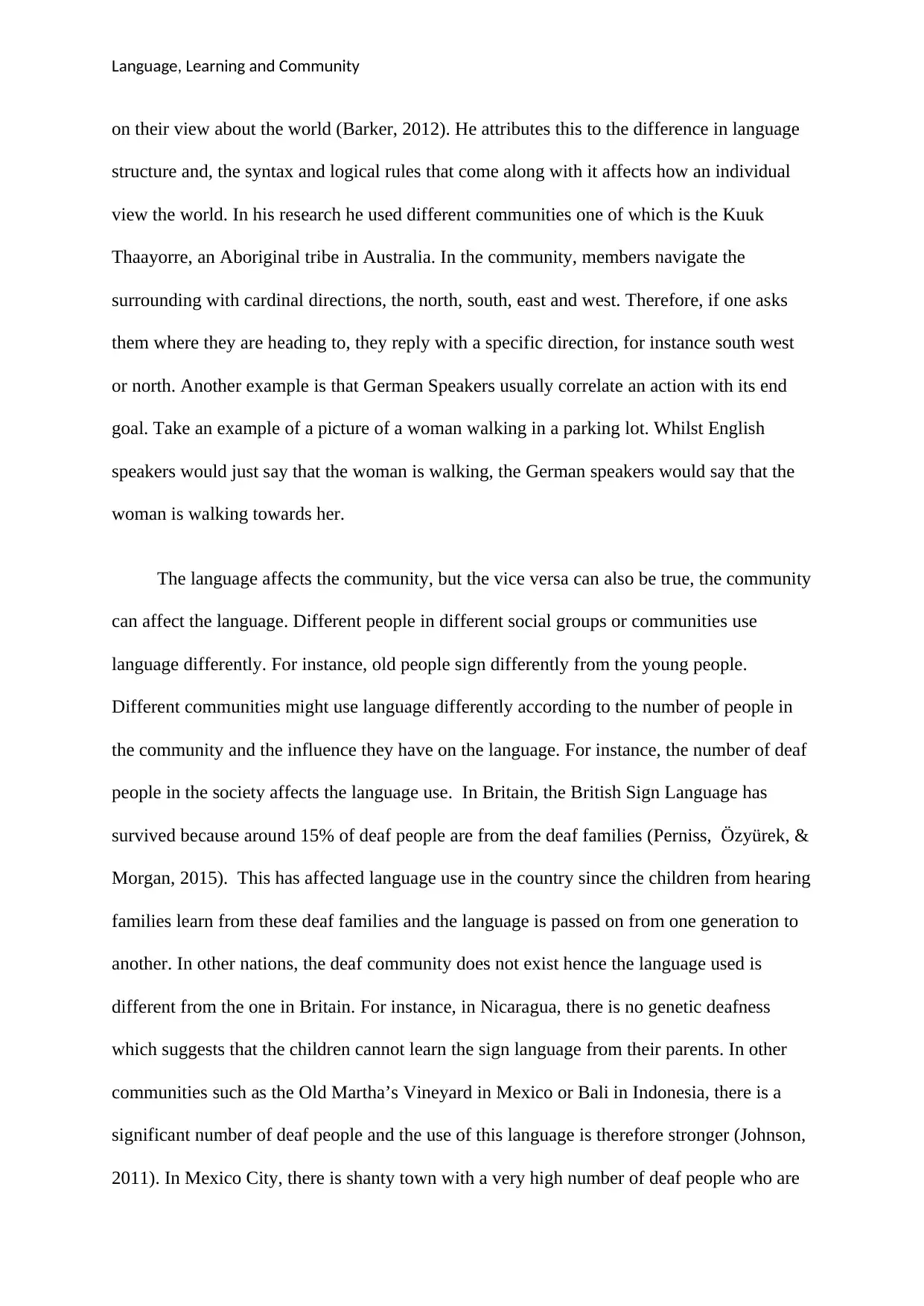
Language, Learning and Community
on their view about the world (Barker, 2012). He attributes this to the difference in language
structure and, the syntax and logical rules that come along with it affects how an individual
view the world. In his research he used different communities one of which is the Kuuk
Thaayorre, an Aboriginal tribe in Australia. In the community, members navigate the
surrounding with cardinal directions, the north, south, east and west. Therefore, if one asks
them where they are heading to, they reply with a specific direction, for instance south west
or north. Another example is that German Speakers usually correlate an action with its end
goal. Take an example of a picture of a woman walking in a parking lot. Whilst English
speakers would just say that the woman is walking, the German speakers would say that the
woman is walking towards her.
The language affects the community, but the vice versa can also be true, the community
can affect the language. Different people in different social groups or communities use
language differently. For instance, old people sign differently from the young people.
Different communities might use language differently according to the number of people in
the community and the influence they have on the language. For instance, the number of deaf
people in the society affects the language use. In Britain, the British Sign Language has
survived because around 15% of deaf people are from the deaf families (Perniss, Özyürek, &
Morgan, 2015). This has affected language use in the country since the children from hearing
families learn from these deaf families and the language is passed on from one generation to
another. In other nations, the deaf community does not exist hence the language used is
different from the one in Britain. For instance, in Nicaragua, there is no genetic deafness
which suggests that the children cannot learn the sign language from their parents. In other
communities such as the Old Martha’s Vineyard in Mexico or Bali in Indonesia, there is a
significant number of deaf people and the use of this language is therefore stronger (Johnson,
2011). In Mexico City, there is shanty town with a very high number of deaf people who are
on their view about the world (Barker, 2012). He attributes this to the difference in language
structure and, the syntax and logical rules that come along with it affects how an individual
view the world. In his research he used different communities one of which is the Kuuk
Thaayorre, an Aboriginal tribe in Australia. In the community, members navigate the
surrounding with cardinal directions, the north, south, east and west. Therefore, if one asks
them where they are heading to, they reply with a specific direction, for instance south west
or north. Another example is that German Speakers usually correlate an action with its end
goal. Take an example of a picture of a woman walking in a parking lot. Whilst English
speakers would just say that the woman is walking, the German speakers would say that the
woman is walking towards her.
The language affects the community, but the vice versa can also be true, the community
can affect the language. Different people in different social groups or communities use
language differently. For instance, old people sign differently from the young people.
Different communities might use language differently according to the number of people in
the community and the influence they have on the language. For instance, the number of deaf
people in the society affects the language use. In Britain, the British Sign Language has
survived because around 15% of deaf people are from the deaf families (Perniss, Özyürek, &
Morgan, 2015). This has affected language use in the country since the children from hearing
families learn from these deaf families and the language is passed on from one generation to
another. In other nations, the deaf community does not exist hence the language used is
different from the one in Britain. For instance, in Nicaragua, there is no genetic deafness
which suggests that the children cannot learn the sign language from their parents. In other
communities such as the Old Martha’s Vineyard in Mexico or Bali in Indonesia, there is a
significant number of deaf people and the use of this language is therefore stronger (Johnson,
2011). In Mexico City, there is shanty town with a very high number of deaf people who are
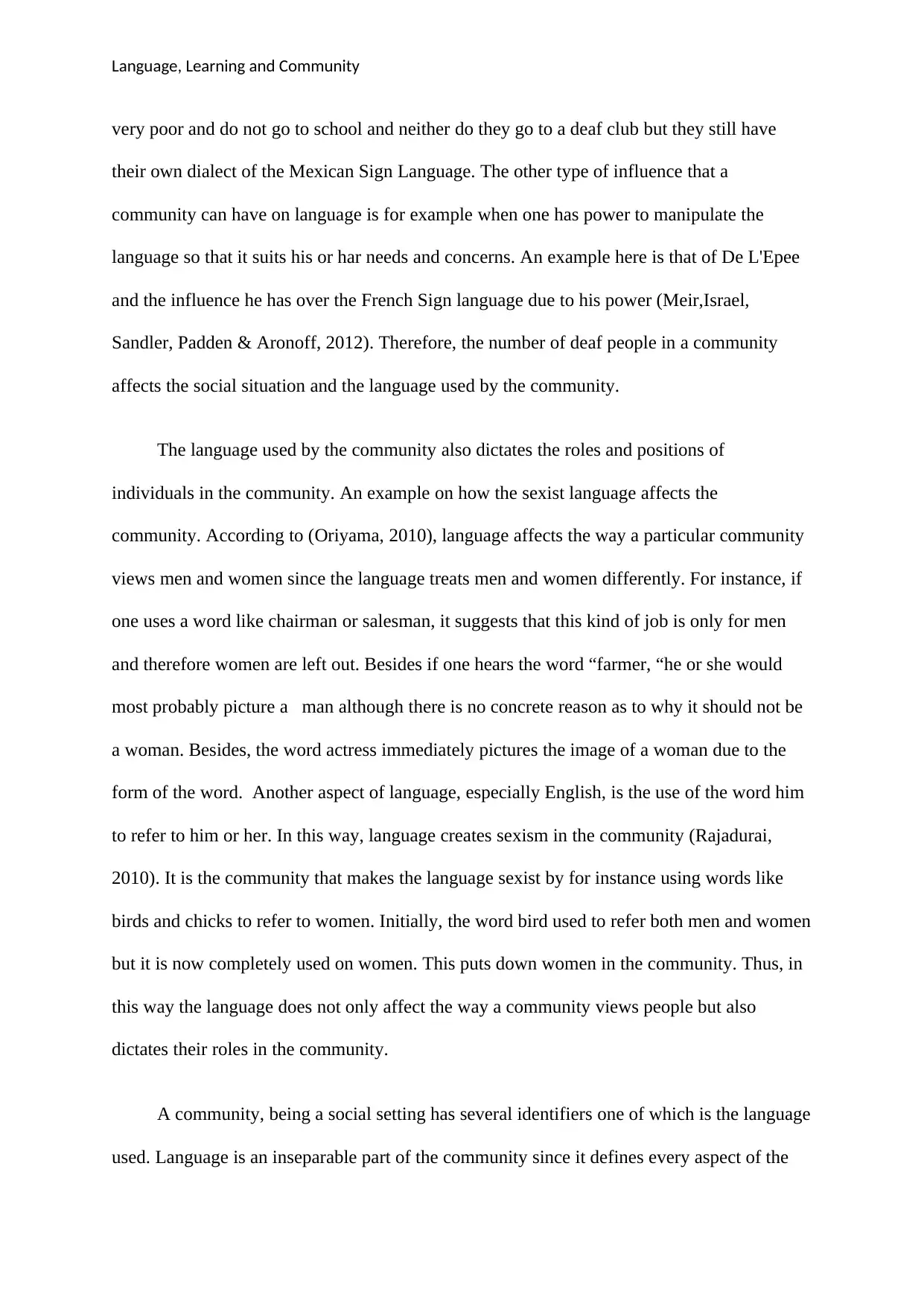
Language, Learning and Community
very poor and do not go to school and neither do they go to a deaf club but they still have
their own dialect of the Mexican Sign Language. The other type of influence that a
community can have on language is for example when one has power to manipulate the
language so that it suits his or har needs and concerns. An example here is that of De L'Epee
and the influence he has over the French Sign language due to his power (Meir,Israel,
Sandler, Padden & Aronoff, 2012). Therefore, the number of deaf people in a community
affects the social situation and the language used by the community.
The language used by the community also dictates the roles and positions of
individuals in the community. An example on how the sexist language affects the
community. According to (Oriyama, 2010), language affects the way a particular community
views men and women since the language treats men and women differently. For instance, if
one uses a word like chairman or salesman, it suggests that this kind of job is only for men
and therefore women are left out. Besides if one hears the word “farmer, “he or she would
most probably picture a man although there is no concrete reason as to why it should not be
a woman. Besides, the word actress immediately pictures the image of a woman due to the
form of the word. Another aspect of language, especially English, is the use of the word him
to refer to him or her. In this way, language creates sexism in the community (Rajadurai,
2010). It is the community that makes the language sexist by for instance using words like
birds and chicks to refer to women. Initially, the word bird used to refer both men and women
but it is now completely used on women. This puts down women in the community. Thus, in
this way the language does not only affect the way a community views people but also
dictates their roles in the community.
A community, being a social setting has several identifiers one of which is the language
used. Language is an inseparable part of the community since it defines every aspect of the
very poor and do not go to school and neither do they go to a deaf club but they still have
their own dialect of the Mexican Sign Language. The other type of influence that a
community can have on language is for example when one has power to manipulate the
language so that it suits his or har needs and concerns. An example here is that of De L'Epee
and the influence he has over the French Sign language due to his power (Meir,Israel,
Sandler, Padden & Aronoff, 2012). Therefore, the number of deaf people in a community
affects the social situation and the language used by the community.
The language used by the community also dictates the roles and positions of
individuals in the community. An example on how the sexist language affects the
community. According to (Oriyama, 2010), language affects the way a particular community
views men and women since the language treats men and women differently. For instance, if
one uses a word like chairman or salesman, it suggests that this kind of job is only for men
and therefore women are left out. Besides if one hears the word “farmer, “he or she would
most probably picture a man although there is no concrete reason as to why it should not be
a woman. Besides, the word actress immediately pictures the image of a woman due to the
form of the word. Another aspect of language, especially English, is the use of the word him
to refer to him or her. In this way, language creates sexism in the community (Rajadurai,
2010). It is the community that makes the language sexist by for instance using words like
birds and chicks to refer to women. Initially, the word bird used to refer both men and women
but it is now completely used on women. This puts down women in the community. Thus, in
this way the language does not only affect the way a community views people but also
dictates their roles in the community.
A community, being a social setting has several identifiers one of which is the language
used. Language is an inseparable part of the community since it defines every aspect of the
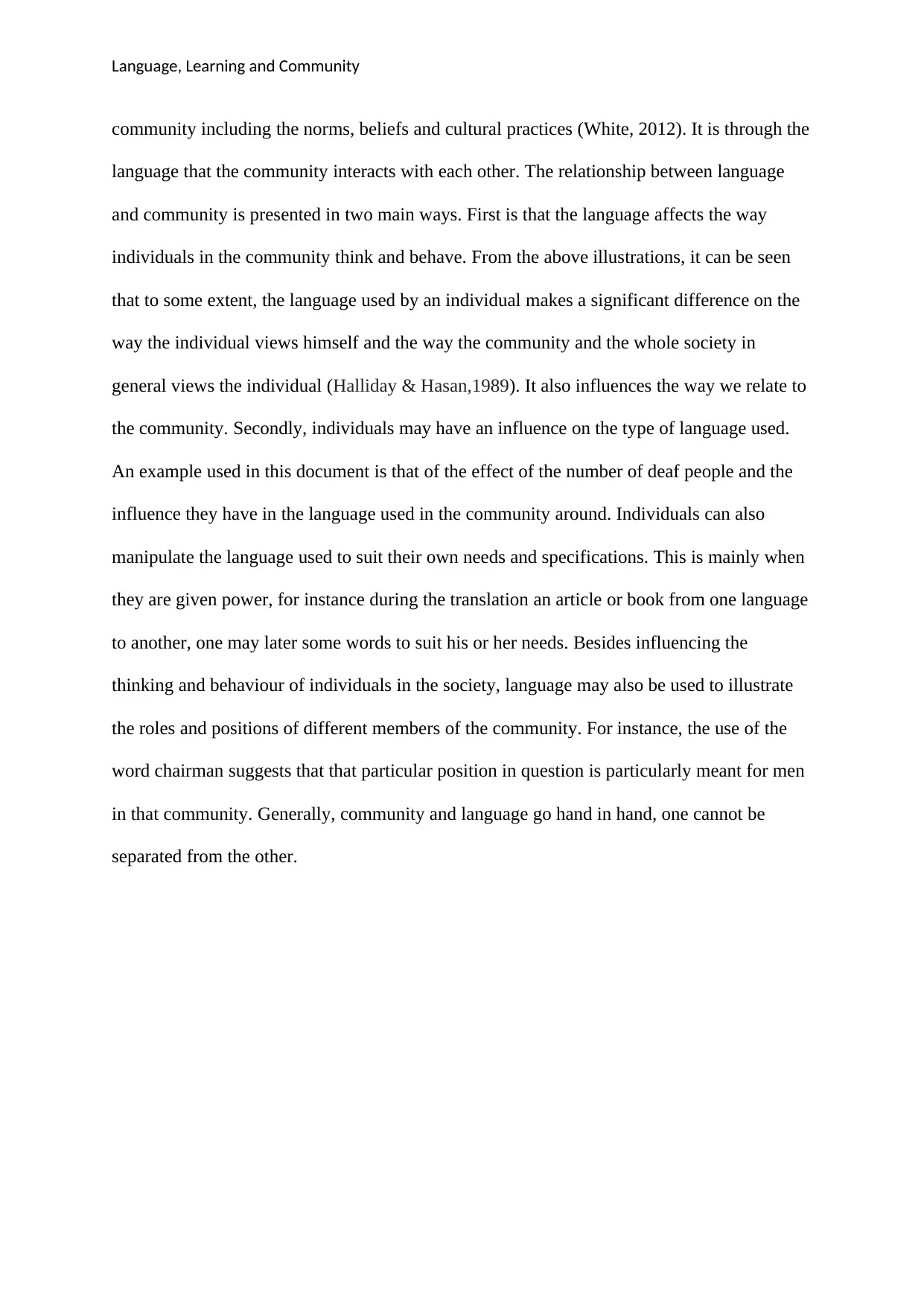
Language, Learning and Community
community including the norms, beliefs and cultural practices (White, 2012). It is through the
language that the community interacts with each other. The relationship between language
and community is presented in two main ways. First is that the language affects the way
individuals in the community think and behave. From the above illustrations, it can be seen
that to some extent, the language used by an individual makes a significant difference on the
way the individual views himself and the way the community and the whole society in
general views the individual (Halliday & Hasan,1989). It also influences the way we relate to
the community. Secondly, individuals may have an influence on the type of language used.
An example used in this document is that of the effect of the number of deaf people and the
influence they have in the language used in the community around. Individuals can also
manipulate the language used to suit their own needs and specifications. This is mainly when
they are given power, for instance during the translation an article or book from one language
to another, one may later some words to suit his or her needs. Besides influencing the
thinking and behaviour of individuals in the society, language may also be used to illustrate
the roles and positions of different members of the community. For instance, the use of the
word chairman suggests that that particular position in question is particularly meant for men
in that community. Generally, community and language go hand in hand, one cannot be
separated from the other.
community including the norms, beliefs and cultural practices (White, 2012). It is through the
language that the community interacts with each other. The relationship between language
and community is presented in two main ways. First is that the language affects the way
individuals in the community think and behave. From the above illustrations, it can be seen
that to some extent, the language used by an individual makes a significant difference on the
way the individual views himself and the way the community and the whole society in
general views the individual (Halliday & Hasan,1989). It also influences the way we relate to
the community. Secondly, individuals may have an influence on the type of language used.
An example used in this document is that of the effect of the number of deaf people and the
influence they have in the language used in the community around. Individuals can also
manipulate the language used to suit their own needs and specifications. This is mainly when
they are given power, for instance during the translation an article or book from one language
to another, one may later some words to suit his or her needs. Besides influencing the
thinking and behaviour of individuals in the society, language may also be used to illustrate
the roles and positions of different members of the community. For instance, the use of the
word chairman suggests that that particular position in question is particularly meant for men
in that community. Generally, community and language go hand in hand, one cannot be
separated from the other.
Paraphrase This Document
Need a fresh take? Get an instant paraphrase of this document with our AI Paraphraser
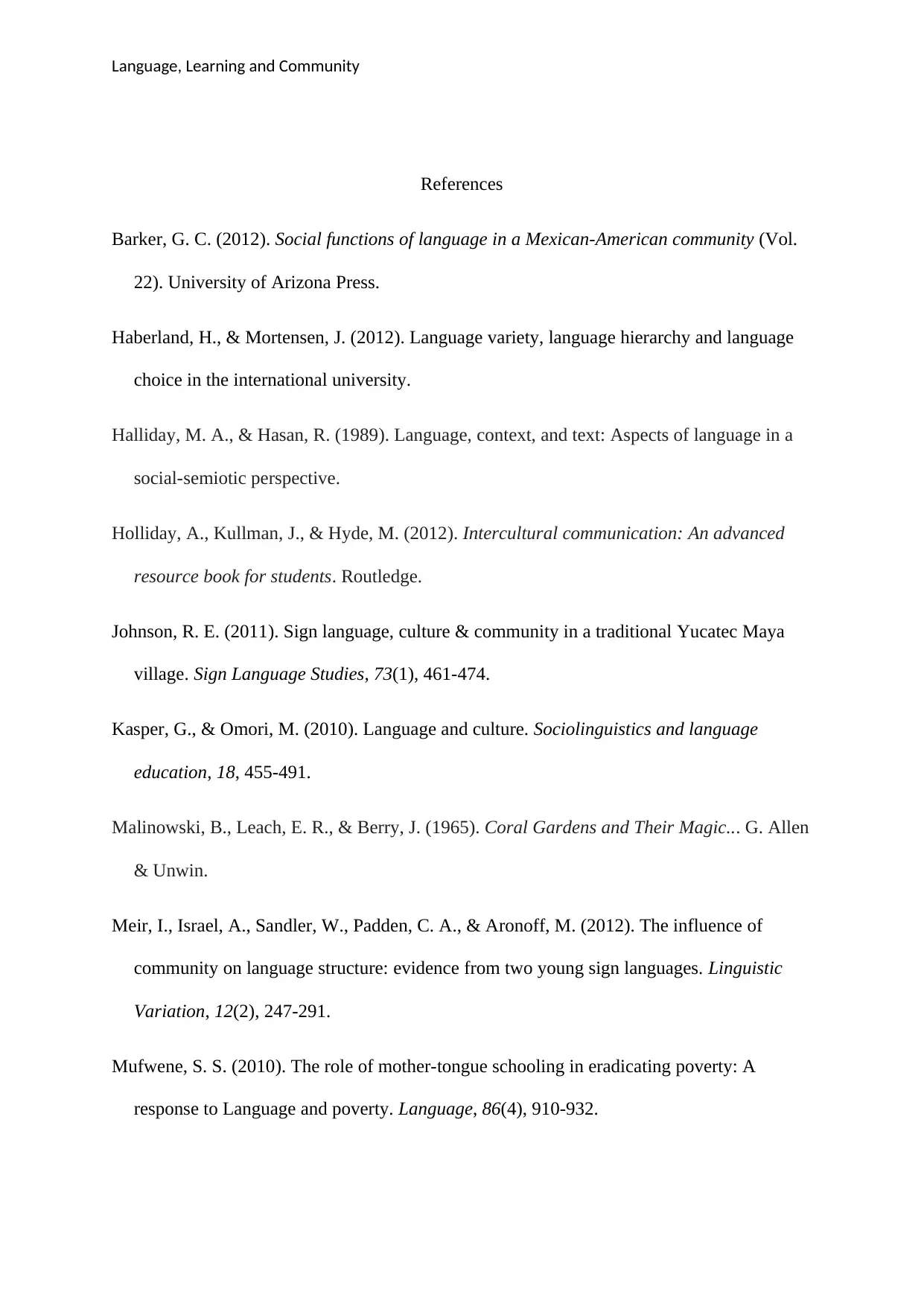
Language, Learning and Community
References
Barker, G. C. (2012). Social functions of language in a Mexican-American community (Vol.
22). University of Arizona Press.
Haberland, H., & Mortensen, J. (2012). Language variety, language hierarchy and language
choice in the international university.
Halliday, M. A., & Hasan, R. (1989). Language, context, and text: Aspects of language in a
social-semiotic perspective.
Holliday, A., Kullman, J., & Hyde, M. (2012). Intercultural communication: An advanced
resource book for students. Routledge.
Johnson, R. E. (2011). Sign language, culture & community in a traditional Yucatec Maya
village. Sign Language Studies, 73(1), 461-474.
Kasper, G., & Omori, M. (2010). Language and culture. Sociolinguistics and language
education, 18, 455-491.
Malinowski, B., Leach, E. R., & Berry, J. (1965). Coral Gardens and Their Magic... G. Allen
& Unwin.
Meir, I., Israel, A., Sandler, W., Padden, C. A., & Aronoff, M. (2012). The influence of
community on language structure: evidence from two young sign languages. Linguistic
Variation, 12(2), 247-291.
Mufwene, S. S. (2010). The role of mother-tongue schooling in eradicating poverty: A
response to Language and poverty. Language, 86(4), 910-932.
References
Barker, G. C. (2012). Social functions of language in a Mexican-American community (Vol.
22). University of Arizona Press.
Haberland, H., & Mortensen, J. (2012). Language variety, language hierarchy and language
choice in the international university.
Halliday, M. A., & Hasan, R. (1989). Language, context, and text: Aspects of language in a
social-semiotic perspective.
Holliday, A., Kullman, J., & Hyde, M. (2012). Intercultural communication: An advanced
resource book for students. Routledge.
Johnson, R. E. (2011). Sign language, culture & community in a traditional Yucatec Maya
village. Sign Language Studies, 73(1), 461-474.
Kasper, G., & Omori, M. (2010). Language and culture. Sociolinguistics and language
education, 18, 455-491.
Malinowski, B., Leach, E. R., & Berry, J. (1965). Coral Gardens and Their Magic... G. Allen
& Unwin.
Meir, I., Israel, A., Sandler, W., Padden, C. A., & Aronoff, M. (2012). The influence of
community on language structure: evidence from two young sign languages. Linguistic
Variation, 12(2), 247-291.
Mufwene, S. S. (2010). The role of mother-tongue schooling in eradicating poverty: A
response to Language and poverty. Language, 86(4), 910-932.
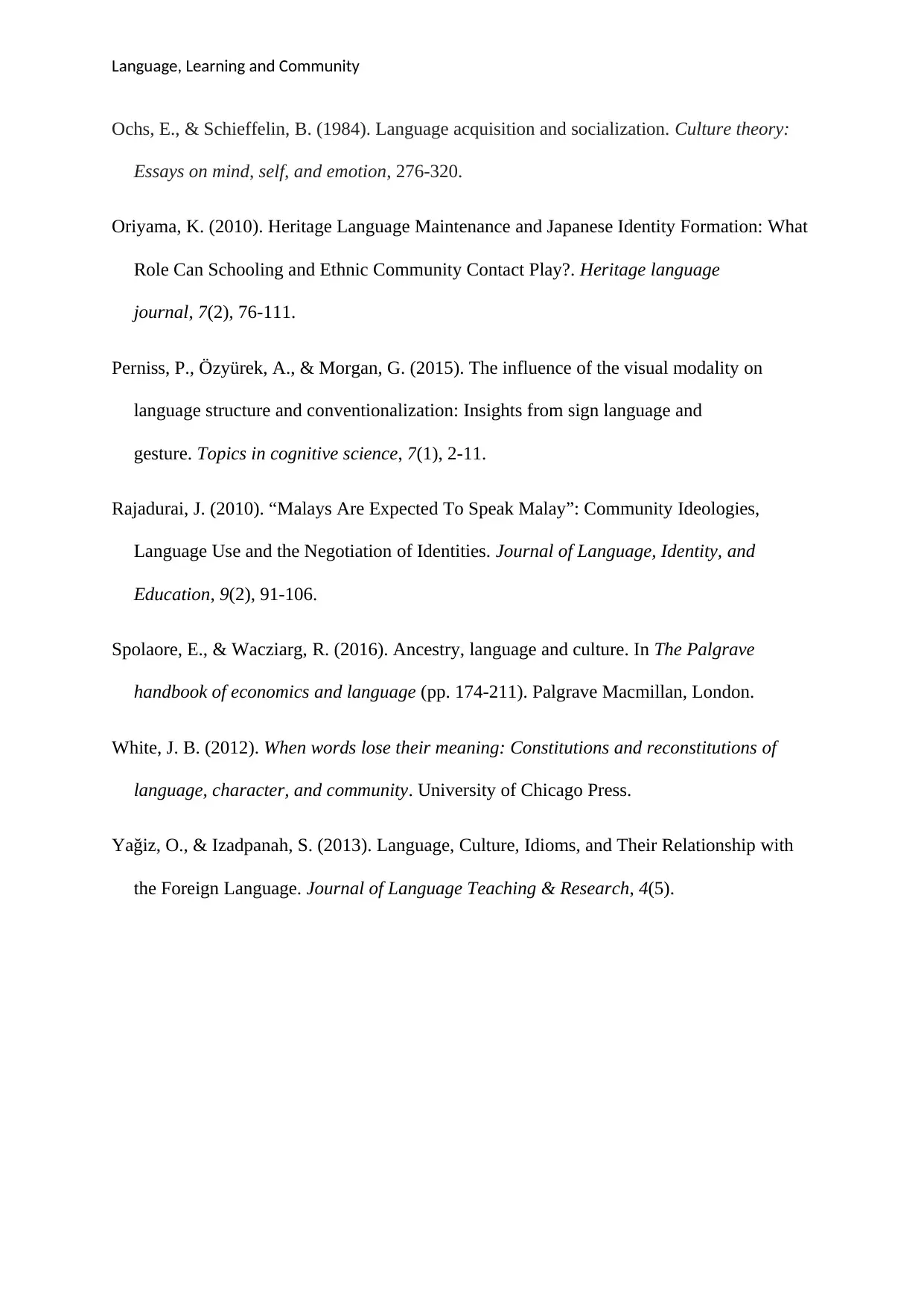
Language, Learning and Community
Ochs, E., & Schieffelin, B. (1984). Language acquisition and socialization. Culture theory:
Essays on mind, self, and emotion, 276-320.
Oriyama, K. (2010). Heritage Language Maintenance and Japanese Identity Formation: What
Role Can Schooling and Ethnic Community Contact Play?. Heritage language
journal, 7(2), 76-111.
Perniss, P., Özyürek, A., & Morgan, G. (2015). The influence of the visual modality on
language structure and conventionalization: Insights from sign language and
gesture. Topics in cognitive science, 7(1), 2-11.
Rajadurai, J. (2010). “Malays Are Expected To Speak Malay”: Community Ideologies,
Language Use and the Negotiation of Identities. Journal of Language, Identity, and
Education, 9(2), 91-106.
Spolaore, E., & Wacziarg, R. (2016). Ancestry, language and culture. In The Palgrave
handbook of economics and language (pp. 174-211). Palgrave Macmillan, London.
White, J. B. (2012). When words lose their meaning: Constitutions and reconstitutions of
language, character, and community. University of Chicago Press.
Yağiz, O., & Izadpanah, S. (2013). Language, Culture, Idioms, and Their Relationship with
the Foreign Language. Journal of Language Teaching & Research, 4(5).
Ochs, E., & Schieffelin, B. (1984). Language acquisition and socialization. Culture theory:
Essays on mind, self, and emotion, 276-320.
Oriyama, K. (2010). Heritage Language Maintenance and Japanese Identity Formation: What
Role Can Schooling and Ethnic Community Contact Play?. Heritage language
journal, 7(2), 76-111.
Perniss, P., Özyürek, A., & Morgan, G. (2015). The influence of the visual modality on
language structure and conventionalization: Insights from sign language and
gesture. Topics in cognitive science, 7(1), 2-11.
Rajadurai, J. (2010). “Malays Are Expected To Speak Malay”: Community Ideologies,
Language Use and the Negotiation of Identities. Journal of Language, Identity, and
Education, 9(2), 91-106.
Spolaore, E., & Wacziarg, R. (2016). Ancestry, language and culture. In The Palgrave
handbook of economics and language (pp. 174-211). Palgrave Macmillan, London.
White, J. B. (2012). When words lose their meaning: Constitutions and reconstitutions of
language, character, and community. University of Chicago Press.
Yağiz, O., & Izadpanah, S. (2013). Language, Culture, Idioms, and Their Relationship with
the Foreign Language. Journal of Language Teaching & Research, 4(5).
1 out of 9
Related Documents
Your All-in-One AI-Powered Toolkit for Academic Success.
+13062052269
info@desklib.com
Available 24*7 on WhatsApp / Email
![[object Object]](/_next/static/media/star-bottom.7253800d.svg)
Unlock your academic potential
© 2024 | Zucol Services PVT LTD | All rights reserved.




